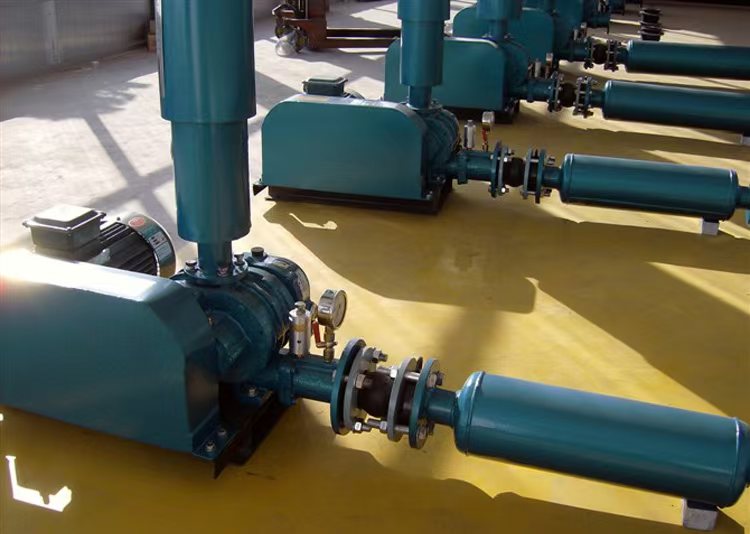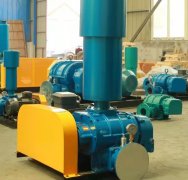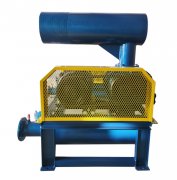Roots blower is a type of positive displacement fan that uses two interlocked rotors to rotate in reverse within a cylinder, drawing gas in from the inlet and forcing it towards the outlet, creating a continuous airflow. Its working principle and structural characteristics are as follows:
---

**1. Core working principle**
-* * Rotor meshing motion * *:
Two three leaf or two leaf rotors (usually involute or pendulum shaped) rotate synchronously in opposite directions inside the cylinder, maintaining a gap (about 0.1-0.4mm) between the rotors and between the rotors and the inner wall of the cylinder, forming a closed chamber.
-Volume change gas transmission:
-* * Inhalation stage * *: When the rotor rotates, the volume on the intake side increases, creating negative pressure and inhaling gas.
-Compression stage: Gas is enclosed in the chamber formed by the rotor and cylinder, and moves towards the outlet as the rotor rotates (without internal compression, pressure is formed by exhaust side resistance).
-Exhaust stage: The chamber is connected to the exhaust port, and the gas is forcibly discharged.
! [Working principle diagram of Roots blower]( https://example.com/roots-blower-diagram.png )
(Schematic diagram: Rotating rotor drives directional flow of gas)
---
**2. Structural composition**
|* * Component * * | * * Function * *|
|-------------------|-------------------------------------------------------------------------|
|* * Rotor * * | Two synchronous gear driven blade rotors determine the air flow and pressure characteristics|
|The cylinder accommodates the rotor, and the inner wall needs to be precision machined to reduce leakage|
|* * Synchronous gear * * | Ensure no contact between rotors and synchronous rotation (clearance controlled by gear accuracy)|
|The intake/exhaust ports are usually located on both sides of the cylinder, and the pressure difference between the inlet and outlet drives the flow of gas|
|Sealing system * * | The shaft end adopts mechanical seal or packing seal to prevent gas leakage|
---
**3. Core Features**
-* * No internal compression * *: The increase in gas pressure only depends on the resistance of the exhaust side system (requiring a pressure relief valve to prevent overpressure).
-* * Constant flow rate * *: The theoretical air volume is proportional to the rotational speed, and is less affected by back pressure (in reality, it slightly decreases due to gap leakage).
-Pulse airflow: Periodic airflow pulsation will be generated when the rotor is engaged (silencer or buffer tank needs to be installed).
-* * Low maintenance * *: No valves, few friction parts, suitable for continuous operation.
---
**4. Performance parameters**
|* * Parameter * * | * * Typical Range * * | * * Explanation * *|
|----------------|--------------------------|------------------------------------------|
|Flow rate | 0.5~500 m3/min | is directly related to speed and rotor size|
|Pressure | ≤ 0.1 MPa (single-stage) | Double stage series connection can reach 0.2 MPa|
|Speed | 500~3000 rpm | High speed requires dynamic balancing|
|Efficiency | 50~70 | lower than centrifugal fans, but with stable flow rate|
---
**5. Difference from centrifugal fan**
|* * Comparison item * * | * Roots blower * * | * * Centrifugal blower * *|
|------------------|--------------------------------------|-------------------------------------|
|* * Working principle * * | Volumetric (mechanical extrusion) | Kinetic (impeller accelerated gas)|
|* * Flow characteristics * * | Constant, basically unaffected by pressure | Significantly decreases with increasing pressure|
|* * Pressure range * * | Medium low pressure (≤ 0.2 MPa) | Wide range (low pressure~high pressure)|
|* * Airflow pulsation * * | Obvious, noise reduction measures required | Stable|
|* * Applicable scenarios * * | Pneumatic conveying, aeration, vacuum suction | Ventilation, dust removal, boiler induced draft|
---
**6. Typical applications**
-* * Sewage treatment * *: Aeration tank oxygen supply (requires anti-corrosion design).
-Pneumatic conveying: Pipeline transportation of granular materials such as cement and grains.
-Vacuum system: Used as a vacuum pump (such as a suction machine).
-Industrial combustion: Supply of combustion supporting air.
---
**7. Common faults and their solutions**
|* * Fault * * | * * Cause * * | * * Solution * *|
|------------------|--------------------------|--------------------------------|
|* * High temperature * * | Gap too large/too small, poor lubrication | Adjust rotor clearance and replace lubricating oil|
|* * Abnormal noise * * | Bearing damage, rotor collision | Replace bearings, check synchronous gear meshing|
|* * Insufficient air volume * * | Belt slippage, clogged filter | Tighten belt, clean filter|
|Oil leakage * * | Aging of seals | Replacement of shaft seals or packing|
---
**8. Key selection points**
1. * * Flow demand * *: Reserve 10-15 margins according to actual working conditions.
2. * * Pressure matching * *: Confirm system resistance to avoid overpressure operation.
3. Material selection: Corrosive gases require stainless steel or coating treatment.
4. * * Noise Control * *: Optional muffler or soundproof cover.
---
**9. Maintenance suggestions**
-* * Daily * *: Check the oil level, vibration, and abnormal noise.
-* * Monthly * *: Clean the intake filter and check the tightness of the belt.
-* * Annual * *: Replace bearing lubricating oil and check rotor clearance.
---
Roots blower has significant advantages in constant flow scenarios due to its simple structure and strong durability, but attention should be paid to its airflow pulsation and noise issues. If further calculation and selection are required (such as motor power formula:\ ( P = \frac{Q \cdot \Delta p}{60000 \cdot \eta} \), Where \ (Q \) is the flow rate m3/min\ (\ Delta p \) is the pressure difference in kPa\ (\ eta \) for efficiency, can provide specific parameters for in-depth analysis.



